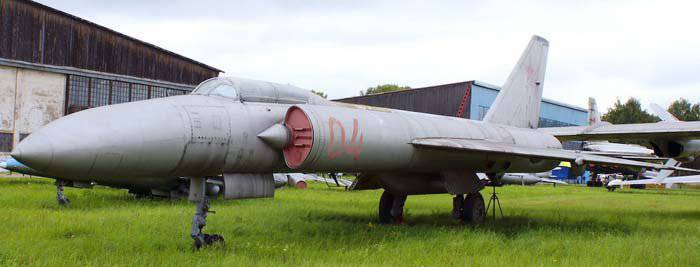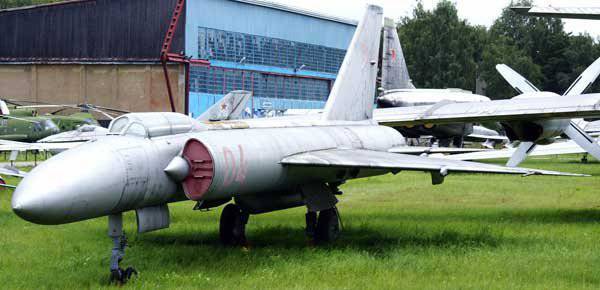Experienced fighter-interceptor LA-250

The development of the project of the distant supersonic La-250 interceptor (250) with the first air-to-air missiles in the USSR and the guidance system began in 1953 in the S. A. Lavochkin EDB-301. The reason for this project was the decision of the Council of Ministers in November of the same year, which became the basis for the deployment of work on the interceptor. It was necessary to create not only an unparalleled aircraft, but also guided missiles. The aircraft was created under the engines of the VK-9 and was intended to hit targets with missiles flying at altitudes up to 20 km at a speed of 1250 km / h. The interceptor was supposed to go into the area of attack according to the information of the ground guidance station "Air-1" and the onboard equipment "Azure".
It is characteristic that the new product had a completely new aerodynamic layout: triangular wings, flat fuselage, all-or-round horizontal tail. Therefore, the design took place for a relatively long time. The layout of the cockpit and equipment units was worked out on the full-scale wooden model of the aircraft. At the same time built a copy of the glider for static tests. Finally, the pilot plant created the first flight model of the La 250. Due to the delay in delivery of the VC-9 engine, the AL-7F engine had to be installed with a much smaller burden, which led to the creation of a practically new La-250А combat aircraft.

The appearance of the aircraft La-250 at the airport caused a storm of emotions, and the “hero of the occasion” himself was dubbed “Anaconda”. In test pilot AG Kochetkov it was the second car with the name of the snake. The first time he tested in the USA was the Bell fighter of the P-39 Aero Cobra during World War II. Runs and approaches were successful, and exactly one month after the aircraft was built, the unexpected happened on the very first flight. In the second second after separation, as follows from the emergency act, the plane tilted to the right then began to transverse oscillations, mainly with the right bank. As the plane descended, it hit the runway with its right foot, then leveled off and flew around 800 m, landed on the edge of the runway. The subsequent movement of the car occurred with the released brake parachute over the ground on the main wheels. Through 1100, the car, breaking through the airfield fence, rolled out onto the sandy ground, breaking the chassis. Surprisingly, but having been in such a "trouble", test pilot A.G. Kochetkov escaped with only bruises, and navigator N.P. Zakharov was completely unharmed. After the experts determined the cause of the fluctuations. It turned out that in the system of irreversible booster control there was a phase shift between the movement of the pilot's handle and the controls. The conclusion was confirmed at a specially created stand by test-pilots G. M. Shiyanov and M. L. Gallai. In a few minutes they “smashed a plane into smoke” no less than ten times each.
After finalizing the control of the aircraft, on the modernized La-250 made the same successful flights the same AG Kochetkov. However, 28 November 1957 g. When landing in adverse weather conditions because of the large nose "Anaconda" he did not see the beginning of the concrete strip and put the car a few meters before it. The chassis was cut down, the plane rolled on the "belly" a hundred meters, caught fire, but the pilot still managed to release the jammed lantern, jump out of the plane and run aside. After the accident, it was decided to lower the nose of the aircraft on the 6 ° assembly from the cockpit canopy to improve visibility. 8 September 1958 (test pilot AP Bogorodsky) while landing was an accident involving the breakdown of the main landing gear. In July, 1959 stopped work on the K-15 system. The third copy of the La-250A is located in the Museum of the Air Force in Monino.
Structurally, the aircraft La-250 is a mid-plane classic scheme with a delta wing and a triangular horizontal tail. The wing of the aircraft with a sweep angle on the leading edge 57 ° and a relative profile thickness of about 6% is performed by a multi-spar scheme. In order to reduce the lateral stability of the aircraft, the wing has a negative lateral V angle equal to 5 °. The front and rear edges of the wing are straight, and the rear edge has a small positive sweep. Like most first-generation Soviet supersonic aircraft, the wing of the La-250 does not have a conical or aerodynamic twist.

The fuselage of La-250 aircraft of circular section in the nose and elliptical in the central and tail parts is made in accordance with the area rule. In the bow, slightly deflected down to improve visibility during takeoff and landing, the radar, the electrical equipment compartment, the crew cabin and the front landing gear niche are placed. Thanks to the use of side air intakes, it was possible to place a large-diameter radar sight antenna in the nose section behind the radio-transparent fairing. The use of such a radar provided a large target detection range and high resolution. The cockpit with the pilot and navigator-operator seats, located one after the other, is equipped with ejection seats and a lantern, significantly protruding beyond the fuselage lines. In the middle part of the fuselage are the air ducts, fuel tanks, attachments of the wing consoles and niches for cleaning the main landing gear. The tail part together with the plumage is detachable, which ensures the speed and convenience of replacing engines.
To control the aircraft in pitch, a controlled triangular-shaped stabilizer is used, in a roll - ailerons located in the end parts of the wing, and along the course - a rudder on a large area keel, which has a sweep along the leading edge 42 °. The design of the keel is two-spar, and the planes of the stabilizer are single-spar with a strut beam. In the tail of the fuselage under the keel is a container of the brake parachute. To improve the take-off and landing characteristics, the wing of the aircraft has flaps that are deflected when taking off at 18 °, and at landing up to 43 °. On the plane La-250 used hydraulic control system with irreversible boosters. To improve the reliability of the hydraulic system is duplicated, and each hydraulic booster has two power supply chambers, each of which is connected to its own hydraulic system. The landing gear is a three-post, normal circuit. The front desk with twin wheels retracts back into the fuselage, and the main struts with single wheels forward. The front landing gear has an increased length, which during an airplane takeoff provides an increase in the angle of attack and lift force of the wing. On the plane La-250 installed two turbojet engine AL-7F designed by AM Lyulka. Air intakes - side, supersonic, unregulated with small fixed semi-cones.
The La-250 aircraft could carry no more than two air-to-air guided missiles with LRE, although four of them were shown in its preliminary scheme: two under the wing and the fuselage. The latter were mixed in tandem, in a partially semi-submerged position under the fuselage one after another and were lowered before the start using a parallelogram mechanism. For armament of La-250 in the S. Lavochkin Design Bureau in 1956, the K-15 rocket was specially developed (La-250-K-15 air defense complex). The aircraft has no gun armament.
Performance characteristics of the La-250
Length, m 26.80
Height, m 6.50
Wing area, m2 80.0
Weight, kg
- empty 18988 aircraft
- normal takeoff 24500
- maximum takeoff 27500
- fuel 5200
Engine type 1 TRD AL-7F
Traction unformed, kgf 1 x 8950
Maximum speed km / h
- without SD 1800
- with SD 1600
Practical range, km 2000
Patrol duration, h 2.3
Practical ceiling, m 17000
Crew 1
Armament: 2 UR air-to-air
Information